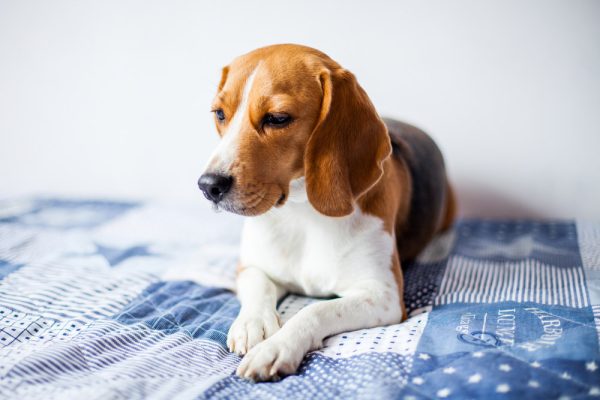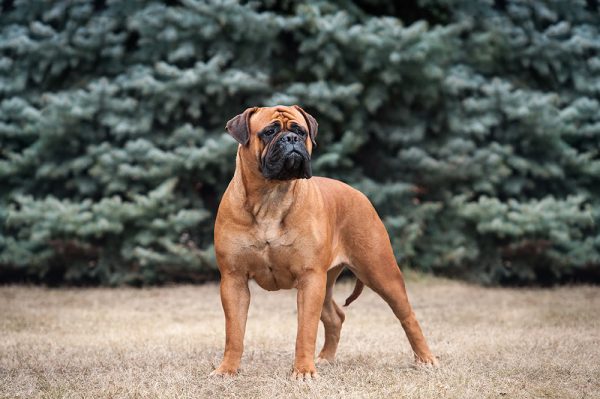In this article
View 2 More +It’s likely that you’ve heard the words “anal glands” at some point during your time as a dog parent. Some of you will shudder at the thought, while others may be blissfully unaware of the problems these seemingly innocuous little sacs can cause.
Whether they’re leaving an unpleasant odor on our furniture, prompting our dog to drag their bottom along the carpet, or even causing them pain and distress, anal glands can be a real pain in the rear (pun intended).
Let’s take a closer look at your dog’s anal glands, the purpose they serve, and the common problems that affect them.

What Are Anal Glands?

Although the terms “anal gland” and “anal sac” are often used interchangeably, this isn’t actually correct. In most cases, when we refer to a dog’s anal glands, we are actually talking about the anal sacs, which are lined with anal glands. There are two sacs that sit just under the skin on either side of the anus, at around the 4 o’clock and 8 o’clock positions, that are attached to the external anal sphincter by a tiny duct.
The glands that line the anal sacs produce a strong-smelling fluid, laden with pheromones that is excreted when the dog passes feces and may express involuntarily in response to shock or fear.
To us, this fluid is decidedly unpleasant, with odors described as sickly molasses, fishy, or just indescribably horrible. On the other hand, it provides a large amount of olfactory information about the owner of the smell, which is why dogs are so preoccupied with sniffing other dog’s poop and shoving their noses where the sun doesn’t shine.
When the anal glands are functioning normally, we don’t tend to think about them. It’s only when our dog starts dragging their bottom along the ground, chewing at their back end, or licking their behind obsessively that we are made aware of their presence.
There are three main anal sac issues that will land your dog at the vet: Impaction (blocked anal sac), infection (anal sac abscess), and neoplasia (benign or malignant anal gland tumor). Let’s take a closer look at each one below.

The 3 Types of Anal Gland Issues in Dogs
1. Anal Gland Impaction
The main reason owners become aware of their dog’s anal sacs is when they become blocked, causing irritation, discomfort, and pain. This usually results in the classic scooting or bum shuffle along the floor in an attempt to empty them, usually in front of guests. This maneuver is often mistakenly attributed to worms, which can cause an itchy bottom but is not the most common cause.
Some dogs will act scared or jump as if they have been bitten as the problematic anal sac makes its presence known in this sensitive area, and some dogs will even run away as though they are trying to escape some invisible assailant.
So, why do dogs’ anal glands fill up? Anal sacs can fill up and become blocked for a number of reasons, including:

- Stress or Competition
When a dog finds themself around other dogs that cause them to feel stressed or pressured, or with whom they feel they need to compete, this can cause an increase in the amount of pheromones and fluid produced. This doesn’t necessarily indicate a problem with the anal sacs, but it can cause them to fill up more quickly than usual, making your dog more uncomfortable.
- Thick Fluid
The type of fluid produced by the anal glands is generally the same in every dog, but it can be affected by a number of factors, such as diet, hydration, and skin conditions. If the material produced is thick, it is more difficult to pass through the ducts, leading to impaction.
- Narrow Ducts
If the ducts that drain the fluid from the anal sacs are particularly narrow, the rate at which the fluid can drain will be reduced. The longer it takes to empty the anal sac, the drier the contents become, compounding the problem even further.

- Obesity
Dogs that are overweight will have difficulty emptying their anal sacs, as the excess adipose tissue (fat) around the anal sacs makes it more difficult for them to be expressed.
- Not Enough Fiber
To empty properly, dogs need to pass decently sized, firm poops that will put pressure on the sac as they pass through the anus. Dogs with diarrhea or small, soft stools will not be able to generate enough pressure to properly empty the sacs.
- Unknown
Some dogs have normal fluid, are producing good-sized stools, and, when manually expressed, the anal sacs empty readily. These are the unknown cases, however, where the anal sacs should be emptying normally but aren’t.
How Are Impacted Anal Glands Treated?
The treatment for impacted anal sacs depends on the cause, but in all cases, the first step is to manually express, or empty, the sacs. This is a procedure your vet or vet tech/nurse can perform and usually involves inserting one finger inside the rectum and firmly squeezing the sac between the finger on the inside and one on the outside. This is pretty uncomfortable and not something your dog will enjoy, but a brief moment of anguish is worth the relief it will provide!
Once the sac has been emptied, there are a number of ways to help reduce the risk of this becoming an ongoing problem.
- Addressing any digestive issues, dietary intolerances, or nutritional deficiencies that may be causing the production of small, soft stools.
- Increasing fiber intake: This can be achieved by making adjustments to the diet, or by including ingredients like pumpkin, psyllium husk, or fiber supplements.
- Assessing your dog’s environment or regular companions to see if there might be any dogs causing them to feel threatened or intimidated.
- Making regular appointments to have your dog’s anal sacs emptied if there is an anatomical problem causing the impaction.
- Following a weight loss plan, if this is a suspected issue.
- Anal sacculectomy: Surgical removal is not usually considered for occasional impactions and is normally only performed in cases of chronic, repeated impaction, infection, or neoplasia (cancer).
If you are concerned about the health and well-being of your pet, we recommend getting in touch with a vet for guidance.
If you need to speak with a vet but can't get to one, head over to PangoVet. It's our online service where you can talk to a vet online and get the advice you need for your dog — all at an affordable price!
2. Anal Gland Infection
Infection of the anal sacs (anal sacculitis) can occur secondarily to impaction but can also occur in dogs with no history of anal gland problems. Infection usually only affects one side, but bilateral infections can occur, sometimes with different types of bacteria.
Dogs with an infected anal sac tend to seem more painful than those with an impaction, and you may notice some redness or swelling to the area over the anal sac. Sometimes the infection goes unnoticed until an abscess forms and ruptures, with blood and pus draining from a hole (sinus) in the skin below the level of the anal sac.
Although anal gland excretions are never appealing, a particularly fetid or disgusting aroma is usually an indication of infection.

How Are Infected Anal Glands Treated?
Initially, your vet may prescribe a combination of broad-spectrum antibiotics, anti-inflammatories, and pain relief. Because it can be difficult to get antibiotic levels into this area, treatment can often last for several weeks. If the infection is not resolving or comes back, a sample should be taken for culture and sensitivity testing, and your vet may recommend that your dog be sedated or anesthetized so that their anal sac can be emptied and flushed with a sterile solution.
Anal sac removal may be recommended for dogs with chronic/recurrent infections, but the infection needs to be under control before surgery can be attempted.
3. Anal Gland Tumors
The anal sacs can be affected by tumors, with the most common being the benign anal gland adenoma and malignant anal gland adenocarcinoma. They often aren’t noticeable from the outside, but your dog will likely show signs that mimic anal sac impaction, and your vet will be able to feel a mass. Anal gland tumors are most common in dogs over the age of 10 years, with both males and females affected equally.

How Are Anal Gland Tumors Treated?
Surgical removal of the affected anal sac is recommended in both instances. A fine-needle biopsy (FNA) may be performed prior to surgery to ascertain whether the tumor is benign or malignant in nature, which can help determine what other tests may need to be performed (e.g., X-rays of lungs to check for metastatic spread, FNA of regional lymph nodes, etc.) and then give a more accurate idea of prognosis.
Removal of a benign tumor should be curative, but the long-term outcome for a dog with malignant anal gland adenocarcinoma will depend on how aggressive and advanced the cancer is.

Frequently Asked Questions
What Are the Risks of Anal Sacculectomy?
As you can imagine, any surgery performed so close to the nerves and muscles of the anus carries some risk of causing problems with defecation, from fecal retention to incontinence. Fortunately, these complications are rare, but they can happen.
Infection is another risk in this area, as it is virtually impossible to keep the surgical field completely sterile, and post-op contamination is a likely risk.
In cases of repeated abscessation, fistulas (tunnels or tubes) can form between the anal sac and rectum, which can lead to tearing and damage to the rectal wall during surgery. This is also a considerable risk if an anal gland tumor is growing close to, or against, the rectal wall. Damage to the rectal wall in this area can be difficult to access and repair and may require more extreme surgery to address.

Do Cats Have Anal Sacs?
Cats have anal sacs in the same location as dogs but seem to suffer from issues less often. Impaction and infection do occur, but tumors are extremely rare.
Do Humans Have Anal Sacs?
Humans do have anal glands in the distal rectum, but they’re not housed in the same sort of sacs as found in dogs. As we tend not to literally sniff out information about our fellow humans, it is likely that these glands are just vestigial, serving no known purpose today. They can occasionally turn into abscesses and fistulas, however.
Can I Empty My Dog’s Anal Sacs at Home?

We don’t recommend this as an initial approach, but if your dog does experience frequent impaction, you can ask your vet to show you how to safely express the anal sacs at home.
- External only: Using pressure on either side of the anus to express the glands.
- Internal: The method used by your vet, with a finger inside and outside the anus.
Talk to your vet if this is something you would like to try.

Final Thoughts
If you are lucky, you may never have to think or worry about anal glands, but it’s still good to be familiar with these smelly little sacs in case your dog develops a problem.
If you’ve noticed an odd smell where your dog has been sitting, or if your dog has been licking or dragging their derriere along the ground, it is time to make an appointment for a checkup with your vet so you can get to the bottom of the problem—pun intended, again!
- Related Read: How to Help a Dog Express Their Anal Glands Naturally
Featured Image Credit: Albina Gavrilovic, Shutterstock






















